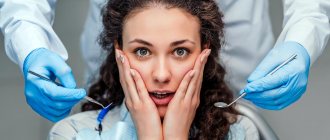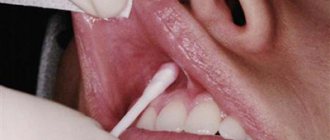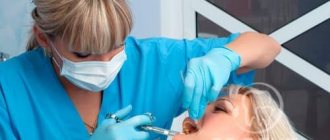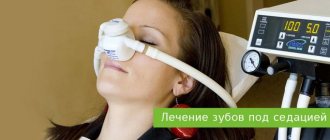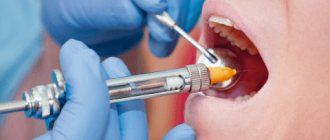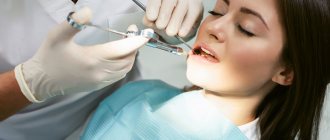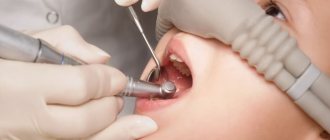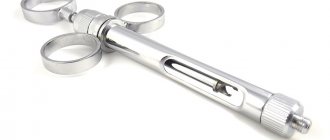Almost every adult whose childhood occurred at the end of the twentieth century has painful memories of visits to the dentist. For some, this has led to chronic neurosis, which occurs just at the thought of dental treatment. However, children living today do not have to endure the same difficulties. Modern dental clinics use the most effective methods of pain relief, including treatment during sleep, when the patient does not feel pain at all and does not even remember the procedure.
Features of anesthesia in children in dentistry
In pediatric practice, pain relief plays a primary role. If an adult patient is able to endure mild discomfort and spend several hours in a row in a chair, then the child’s psyche is not yet ready for this. A painful procedure can instill a lifelong fear of dentists and interfere with quality treatment. Moreover, anesthesia gives the desired psychological effect and helps the child trust the doctor.
Features of pain relief in children
- Most drugs can only be used from the age of four, which imposes severe restrictions on the treatment of very young patients.
- The anesthesiologist must be highly qualified and be able to correctly calculate the dosage.
- The child may be afraid of treatment and dental instruments, especially needles.
- Children are often allergic to anesthetics.
How DLclinic dentistry treats children with pain relief
Since pediatric dentistry is rapidly progressing in our time, and the main vector of development is aimed at results, dental treatment for children follows the same algorithm as for adult patients, namely:
- before treatment, the tooth is isolated from the rest by means of a rubber dam (a special “rubber scarf” that is put on it), so that infection does not enter the tooth cavity, and the doctor can work in sterile conditions;
- To restore the anatomy of a tooth in cases of large amounts of destruction in children, as well as in adults, the doctor uses special means: matrices, wedges, rings, etc., due to which the effectiveness of treatment increases significantly.
If we carry out this treatment without the use of anesthesia, at a minimum, we will form a negative attitude towards the doctor in the child, and at maximum, the child will never voluntarily enter the dentist’s office again. It is very important not to neglect either quality or comfort when treating small patients.
Types of pain relief in children in dentistry
Local anesthesia
The most common method of pain relief in pediatric practice. Most often, it is carried out in two stages, combining a “freezing” gel or spray with an anesthetic injection.
General anesthesia
Sometimes it may be the only way to carry out treatment. They try not to use it without good reason, since the likelihood of complications after dental treatment under anesthesia is higher than after local anesthesia.
Sedation
This is an inhalation of a soothing mixture that allows the child to relax, but at the same time be conscious. Formally, sedation is not anesthesia, but it provides a slight analgesic effect and is often used in conjunction with an injection of an anesthetic.
Sedation
A good alternative to general anesthesia is nitrous oxide sedation (NAS). Nitrous oxide is an inert gas, absolutely harmless and quickly eliminated from the body unchanged. The child breathes a mixture of this gas and oxygen through a nasal mask. At the same time, he relaxes greatly, and his mood improves (this state can be compared to intoxication from a glass of champagne).
Since the analgesic effect of sedation is minimal, simultaneously with it during dental treatment for children
local anesthesia
is often used. Sedation is suitable only for mild cases, but it has a number of advantages over general anesthesia:
- minimum contraindications;
- the ability to communicate with the patient;
- rapid elimination from the body;
- no health consequences;
- minimal risk of allergies.
Nitrous oxide sedation is used as an alternative to general anesthesia for the treatment and removal of primary teeth.
when anesthesia is not applicable or is excessive. Being in a relaxed state, a child can calmly spend more than an hour in the dental chair (whereas usually he can barely stand it for 20 minutes). The main condition is that the child must breathe independently through the mask.
Local anesthesia in children in dentistry
Local anesthesia for dental treatment is used everywhere, since it provides the necessary analgesic effect, but at the same time maintains a certain sensitivity and has the fewest contraindications. Children, as a rule, tolerate it well.
Types of local anesthesia
The choice of one type or another depends on the procedure to be performed by the doctor, the age and psychological state of the child.
Application anesthesia
Local anesthesia in children in dentistry is not complete without the use of special anesthetic solutions or gels (most often based on lidocaine), which are used to treat the gums before starting treatment. The active substance easily passes through a thin layer of the mucous membrane and dulls sensitivity. As a rule, topical anesthesia is used to numb the site of the future injection - this is a typical feature of anesthesia in children in dentistry. But even one “freezing” with a gel or spray is enough for some procedures - for example, to remove mobile baby teeth, the roots of which have almost completely dissolved.
Topical anesthesia products in children's clinics have a pleasant taste and aroma to make it easier for the child to tolerate treatment.
Injection anesthesia
In pediatric practice, articaine-based anesthetics are most often used, which are administered using a syringe. This drug is approximately five times more powerful than novocaine, but is less toxic and less likely to cause allergies. It can be prescribed from the age of four.
Injection anesthesia has its own varieties. Pediatric dentists use infiltration or conduction anesthesia depending on the indications. In the first case, an injection is made into the mucous membrane at the border of the alveolar process and the transitional fold so that the anesthetic reaches the endings of the dental nerves. In the second case, the solution has an effect on the branches of the trigeminal nerve. Conductive anesthesia in children in dentistry is permissible from the age of six and is indicated for tooth extraction - mainly in the lower jaw.
Instruments for injection anesthesia
In children's clinics, they are gradually moving away from the use of classic syringes and ampoule solutions. They are replaced by more thoughtful and, importantly, psychologically comfortable solutions for the child.
- Needleless injector.
The anesthetic in such a device is supplied through a minimal (up to 0.1 millimeter) hole under very high pressure. The jet penetrates the surface of the mucous membrane or skin and enters the tissue. The analgesic effect with this principle of administration occurs faster, and a smaller volume of the drug is required. The absence of a needle in the injector is the key to a child’s good mood. - A carpule syringe
is a cartridge containing an anesthetic and, usually, a vasoconstrictor that helps prolong the pain-relieving effect of the solution. Unlike traditional ampoules, the carpule provides ideal sterility and more accurate dosage of all components. A special needle is placed on the cartridge: it is much thinner than the needle of a regular syringe and minimizes discomfort. - A computer syringe
is completely different from a regular syringe, so pain relief will be more comfortable for the child. The supply of solution in such a device is controlled electronically, and for the desired effect a smaller dosage of the drug is required. When the anesthetic is administered using a computer syringe, the child's face will not be as numb, so he will feel better during treatment.
What is the difference between pediatric anesthesia and adult anesthesia?
Features of pediatric anesthesia are determined by the characteristics of the child’s body.
For example, a child’s body needs 2 times more oxygen than an adult. Also, the children's body is characterized by a rapid change in physiological states and an increased ability to adapt. At the same time, children are more sensitive to changes in ambient temperature, have increased emotionality, and find it difficult to remain in one position for a long time. There is a high probability of allergic reactions in children, and the smaller the child, the more caution you need to choose the drug.
Therefore, when performing pediatric anesthesia, the following rules must be observed:
Accurately select the anesthetic drug and its dose. There is some difficulty in treating pain in children under 4 years of age, because... Most local anesthetics are used from the age of 4. For a child prone to allergies, it is better to conduct special allergy tests to know exactly which drug is safe for him.
The anesthetic should be administered to the child as gently as possible. Children are often afraid of tools, and even more so of syringes. Before the injection, the needle insertion site should be treated with a tasty anesthetic gel, which “freezes” the gum. Today, a large selection of such drugs is available.
Due to increased sensitivity to ambient temperature, a child may feel cold during treatment in a cool room, or vice versa - hot if the room is poorly ventilated and too small. This factor must be taken into account.
Do not neglect the method of premedication before visiting the dentist. Taking a sedative will help your child relax and be less afraid.
A very important component is the doctor’s personality. A good pediatric dentist finds an approach to parents and children and turns fear into interest. Advice to parents: help him with this to the best of your ability.
General anesthesia in pediatric dentistry
Sometimes in pediatric practice it is necessary to use general anesthesia. There must be serious reasons and indications for treating or removing teeth for children under anesthesia, because anesthesia is a deep depression of the nervous system, and this kind of exposure entails a risk of complications. A lot depends on the qualifications of the anesthesiologist: he must correctly calculate the dosage and take into account all the characteristics of the child’s body.
The anesthetic for general anesthesia is administered by inhalation. The child inhales the vapor of the substance and quickly falls asleep. This way, the doctor has the opportunity to carry out treatment in a calm environment, quickly and efficiently, while the little patient will not receive psychological trauma.
Indications for general anesthesia:
- A lot of work. It is difficult for a child to sit still, and if several teeth need to be treated in one session or a complex operation must be performed, then this mission becomes almost impossible.
- Allergy to drugs for local anesthesia. Articaine and other similar anesthetics may cause an allergic reaction. In this case, anesthesia may be the only solution.
- Ineffectiveness of local anesthesia. Sometimes the injection does not provide the required degree of pain relief due to the characteristics of the baby’s body. If the child remains highly sensitive, it is better to use anesthesia.
- Insurmountable fear of treatment. Severe dental phobia is an indication for general anesthesia if the child cannot be distracted from his worries with affectionate words, cartoons or toys.
- Some mental and neurological diseases (cerebral palsy, epilepsy, Down syndrome and the like).
What to do if your child has allergies?
Allergy to anesthesia in dentistry in children is a fairly common occurrence. The child's body is more susceptible to unusual reactions to new substances, which include anesthetics. Before visiting the dentist, it is necessary to undergo tests to understand whether local anesthesia is acceptable, and if an allergic reaction does occur, treatment is carried out under anesthesia.
General anesthesia
Anesthesia is used in pediatric practice, but the procedure is performed only by an anesthesiologist with a preliminary examination of the child and the exclusion of contraindications. Anesthesia depresses the nervous system and can cause side effects, so it is used strictly according to indications and under medical supervision. The anesthesiologist must be highly qualified, since it is more difficult to calculate the exact dosage for a child than for an adult.
Types of anesthesia for treating children
In dentistry, two methods of general anesthesia are used:
Inhalation. A mask is put on the child and an anesthetic is given. After just a few breaths, he falls into a medicated sleep. This method is more gentle, since the dosage is easier to control during the process, and side effects are rare. Sevoran is considered the most effective and safe mask preparation today.
Intravenous. For young children, an intravenous catheter is installed and Diprivan or its analogues are administered. The dosage of the drug and the duration of drug-induced sleep are established by the anesthesiologist-resuscitator. Treatment must be coordinated with parents or other guardians.
How to prepare your baby for anesthesia
Preparing a child for treatment under anesthesia is a mandatory condition that should never be neglected. You will first need to undergo a series of tests, undergo an ECG, visit a therapist and other doctors (as directed) to obtain permission for general anesthesia. It is necessary to protect your child from colds, since if an infection develops, the date of the procedure will be postponed until complete recovery.
On the day of treatment, food is prohibited for at least six hours, and drinking for four hours. It is important to make sure that the baby does not eat anything behind his back, try to distract him, for example, with a walk, reading a book, etc. The day before, you need to feed the child light but nutritious food.
Indications and contraindications for the procedure
Traumatic dental procedures may require general anesthesia, but this decision depends not on the parents, but on the anesthesiologist.
In what cases is anesthesia justified or even necessary:
- complex operation, large amount of work;
- children under three years of age;
- allergy to local anesthetics;
- low pain threshold;
- Dentophobia (dentophobia) - insurmountable fear;
- pronounced gag reflex;
- a number of neurological or mental diseases.
The use of anesthesia is prohibited during periods of acute respiratory infections, in case of any infectious or inflammatory diseases of the respiratory tract, heart failure, heart defects, underweight, allergies to the drugs used.
Advantages and disadvantages
Treatment with anesthesia has many advantages:
- there is no psychological trauma, since the little patient falls asleep before the operation, and after waking up does not remember anything;
- absolutely painless;
- the doctor is focused on the procedure and is not distracted by the baby, which means medical errors are excluded;
- You can perform a large amount of work, including procedures of any complexity.
The disadvantages include the introduction of serious general medications into the body, which can cause negative reactions. After the procedure, the child remains lethargic for 6–8 hours and requires increased attention from medical staff and parents.
Is it dangerous to treat a child’s teeth under anesthesia?
General anesthesia in pediatric dentistry is not a whim of parents, but sometimes the only possible method of anesthesia. Temporary, as well as permanent teeth, must be treated, since infection and inflammatory processes in the oral cavity deplete the immune system, and premature loss of teeth leads to malocclusion. According to the law of the Russian Federation and a number of other countries, children under three years of age receive dental services only under anesthesia.
General anesthesia has long been safe, as it is carried out using non-toxic drugs, under the supervision of an anesthesiologist-resuscitator and modern equipment. If a child is forced into a chair and treated, the harm will be more significant than the possible side effects. Sometimes after the procedures, children begin to suffer from enuresis, stuttering, dental phobia and other disorders.
Alternative to general anesthesia
Sedation is considered a safer alternative to general anesthesia. This procedure involves inhaling a special mixture of nitrous oxide and oxygen through a mask. It makes the child feel relaxed and slightly drowsy, lifts his spirits and calms him down. At the same time, the small patient remains conscious and can interact with the dentist.
Sedation is not anesthesia, but has a slight analgesic effect. It is usually combined with an anesthetic injection. The mixture of gases is supplied through a special device that controls the duration and dosage and allows you to smoothly enter and exit the state of sedation. The effect of the procedure wears off within about 10 minutes after stopping the supply of nitrous oxide.
General anesthesia
If local anesthesia is not enough, general anesthesia can be used. It completely relieves the child of pain, vibration, loud sounds, gag reflex and other unpleasant sensations. In some situations, anesthesia may be the only available way to treat a child’s teeth.
General anesthesia in dentistry for children
provides benefits such as:
- the opportunity to work with children who are terrified of dental treatment;
- minimum stress for the child and parents;
- the ability to carry out all manipulations quickly and efficiently;
- absence of negative experiences for the child, thanks to which he will not be afraid to have his teeth treated in the future.
In pediatric dentistry
the safe drug “Sevoran” is used, which is even used as
anesthesia for pregnant women during dental treatment
and other operations. This is an inhalation drug that is supplied through a special tube directly into the trachea, without interfering with the dentist’s work in the patient’s oral cavity; after the supply is stopped, it is also excreted by the lungs without remaining in the body.
Features of dental treatment under general anesthesia
Manipulations are carried out “with four hands” - a doctor and an assistant, in order to achieve maximum accuracy. To work with filling materials, it is rational to involve a second assistant. Treatment is optimally carried out in segments, for example, first the upper right, then the upper central, etc. This allows you to reduce time, since closely spaced teeth have a similar treatment plan due to an identical diagnosis.
Sometimes, in addition to general anesthesia, the patient is given local anesthesia as indicated. For this purpose, articaine anesthetics without vasoconstrictors are used.
Preparation for general anesthesia
The preparatory stage includes the following procedures:
- orthopantomogram;
- oral cavity examination;
- drawing up a treatment plan based on an x-ray image;
- collecting anamnesis using a questionnaire filled out by parents;
- consultation with a pediatric anesthesiologist and pediatrician;
- necessary laboratory tests;
- registration of written voluntary consent to the procedure.
The child must refuse food and liquids for a certain period of time before anesthesia to prevent the pharyngeal reflex. This period is determined by the anesthesiologist. As a rule, it is 6 hours for food, including kefir, milk, juices and pulp, and 4 hours for liquids. For children under one year old it is reduced to four hours.
Spray irrigation method
According to the results of clinical studies, the most pronounced analgesic effect in the treatment of caries of temporary teeth is provided by sprays and aerosols, for example Lignospam, Lidokain 10%, Legekain, etc. Anesthesia occurs after 30-40 seconds and lasts for 15 minutes. Due to their unpleasant taste, gels and aerosols are contraindicated in children under four years of age, as they increase salivation and can enter the respiratory tract and cause respiratory arrest.
Older children also complain of local symptoms after irrigation - numbness of the laryngeal tissue, sensation of a lump in the throat, hoarseness, which sometimes lead to breathing problems. Therefore, before using sprays and aerosols, the dentist must tell the patient how to behave correctly and make sure that he has accepted the information. This type of anesthesia can only be done while exhaling, but it is safer to apply the product to a cotton swab and apply it to the area, similar to liquid solutions.
Indications for treatment under anesthesia:
1. The patient is young.
2. Allergy to local anesthetics.
3. High gag reflex.
4. The presence of concomitant diseases of the nervous system or a number of other serious diseases in which a stressful situation can lead to a significant deterioration in the underlying disease. In most cases, these are indications for dental treatment in a hospital setting, but under anesthesia. Treatment under local anesthesia is contraindicated in such patients.
5. Multiple caries.
Contraindications to general anesthesia
Under certain conditions, general anesthesia is contraindicated:
- with decompensated heart disease;
- for renal failure and liver diseases;
- with diabetes mellitus in the stage of decompensation;
- with severe forms of rickets;
- after the actual meal.
In case of increased bleeding and decreased blood clotting, before anesthesia, the patient should consult a hematologist and give the dentist permission to use this method for pain relief.
